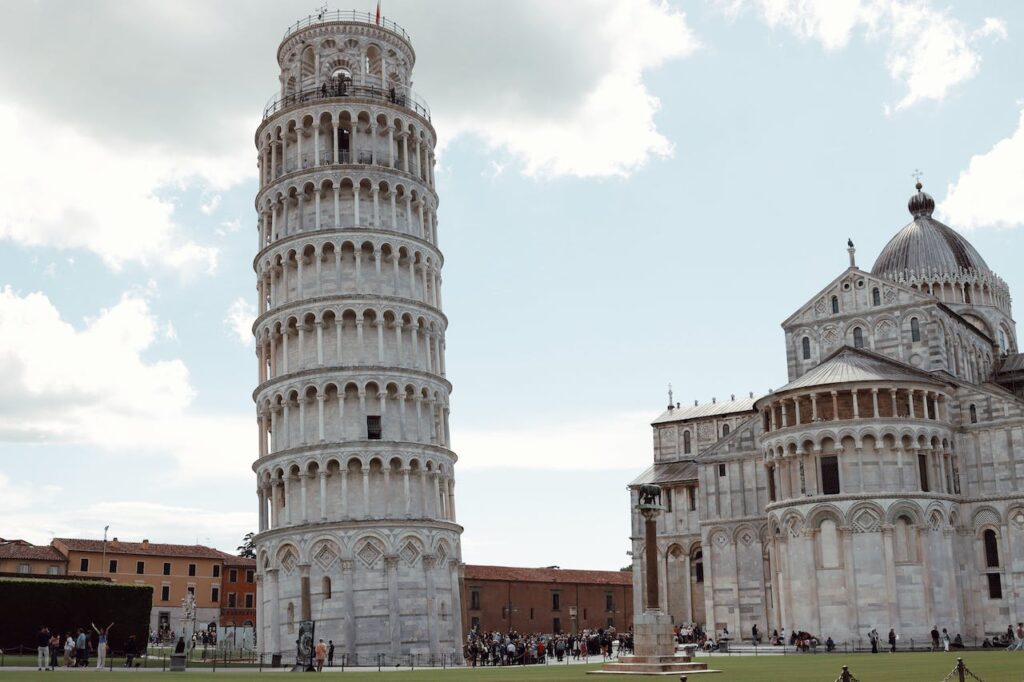In the heart of the picturesque city of Pisa, Italy, stands a remarkable structure that has captivated the world for centuries – the Leaning Tower of Pisa. This iconic leaning tower, with its distinctive tilt, is not only a testament to architectural marvel but also a symbol of human perseverance and the unpredictable nature of historical endeavors. As we embark on a journey through time, we unravel the mysteries surrounding this medieval marvel that has defied gravity and garnered global fame.
Page Contents
Historical Context
The Leaning Tower of Pisa, or “Torre Pendente di Pisa” in Italian, was originally conceived as the freestanding bell tower for the Cathedral of Pisa. Construction began in the summer of 1173 and continued intermittently for almost two centuries, finally reaching completion in the mid-14th century. The tower’s initial purpose was utilitarian, serving as a grandiose platform for the cathedral’s seven bells, including the largest one, known as “Pasquareccia.”
Read Also : The Lighthouse of Alexandria: Guiding Light of Antiquity
The Architectural Marvel
The Leaning Tower of Pisa is a marvel of medieval architecture, boasting a height of approximately 56 meters (183 feet) and comprised of eight stories, including the chamber for the bells. Built on a circular plan with a diameter of 15.5 meters (50.9 feet), the tower was constructed using white and grey marble from the quarries of San Giuliano, near Pisa.
The tower’s distinctive lean is not the result of deliberate design but rather an unintended consequence that has made it famous. The tower’s foundation consists of layers of clay, fine sand, and shells, which, combined with the tower’s considerable weight, caused the structure to gradually tilt during construction. As builders added subsequent levels, they attempted to compensate for the lean by making the columns on one side taller than those on the other. However, this only exacerbated the problem.

Construction Challenges
During the tower’s construction, the region was embroiled in political turmoil, with Pisa frequently at odds with other Italian city-states. Wars and conflicts disrupted the construction process, causing long pauses in the building efforts. These interruptions unintentionally benefited the tower by allowing the underlying soil to settle and solidify, stabilizing the structure to some extent.
The Great Pause and Architectural Innovations
One of the most intriguing aspects of the Leaning Tower of Pisa’s story is the prolonged construction pause. After reaching the third floor in 1178, the project came to a halt due to Pisa’s involvement in various military conflicts. This unintended hiatus, which lasted almost a century, provided the soil beneath the tower with the much-needed time to settle.
When construction resumed in 1272 under the guidance of Giovanni di Simone, architects employed ingenious methods to counteract the tilt. The builders adjusted the heights of the columns on each floor, attempting to create an illusion of verticality. These efforts, while not entirely successful in straightening the tower, did contribute to its unique and visually captivating lean.
Scientific Inquiry
As the centuries passed, scientists, engineers, and architects sought to understand the physics behind the tower’s lean. It wasn’t until the late 20th century that serious efforts were made to prevent the tower from collapsing. Engineers began to intervene with measures such as soil extraction and cable tightening to counteract the tilt and stabilize the structure.
In 1990, the Leaning Tower of Pisa was closed to the public for the first time in its history to undergo extensive restoration and stabilization efforts. A significant feat of engineering, the tower was carefully anchored and supported, and the soil beneath it was excavated to reduce its weight. After a decade of meticulous work, the tower was reopened to the public in 2001, with its lean reduced to a safer angle.
Symbolism and Cultural Impact
Beyond its architectural significance, the Leaning Tower of Pisa has become a symbol of human resilience and the triumph of creativity over adversity. It stands as a testament to the enduring spirit of the people who, over centuries, worked tirelessly to both build and preserve this cultural treasure.
The tower’s tilt has also made it a global icon, attracting millions of visitors from around the world. Tourists flock to Pisa not only to marvel at the tower’s precarious lean but also to climb its spiraling staircase for breathtaking views of the surrounding city and countryside.
Art and Literature
The Leaning Tower of Pisa has inspired artists and writers throughout the ages. It has been featured in countless paintings, poems, and novels, becoming an enduring muse for creative minds. The tower’s lean serves as a metaphor in literature, symbolizing the unpredictability of life and the beauty that can arise from imperfections.
One of the most famous literary references to the tower is found in Dante Alighieri’s “Divine Comedy,” where he compares the sin of envy to the tilt of the tower. The tower’s lean, in this context, becomes a metaphor for the moral and spiritual imbalances that individuals must strive to overcome.

Tourist Attraction and Global Landmark
Today, the Leaning Tower of Pisa is not only an architectural wonder but also a thriving tourist attraction. Its global fame is such that Pisa’s Field of Miracles, where the tower is located, has been designated a UNESCO World Heritage Site. The site also includes the Pisa Cathedral, the Baptistery, and the Camposanto Monumentale, forming a stunning ensemble of medieval art and architecture.
The Leaning Tower of Pisa has become synonymous with Italy, representing the country’s rich history, cultural heritage, and artistic prowess. Its distinctive silhouette is instantly recognizable, gracing postcards, travel brochures, and the imaginations of people worldwide.
Read also : Christ the Redeemer: Brazil’s Iconic Symbol of Faith and Culture
Conclusion
The Leaning Tower of Pisa is more than a tilted architectural marvel; it is a living testament to human ingenuity, perseverance, and the enduring allure of the past. From its tumultuous construction history to its modern-day status as a global icon, the tower stands as a symbol of the unpredictable journey that history often takes. As visitors from every corner of the globe continue to marvel at its lean and climb its spiraling staircase, the Leaning Tower of Pisa remains a timeless reminder that even in imperfection, there is beauty and resilience worth celebrating.


